 Things weren't going too well in Chiang Mai. And then I had my first cup of locally grown hill tribe coffee. The flavor was rich, sweet and without bitterness, and with just the slightest hint of acidity. So good, I drank it without milk. Mmmm...
Things weren't going too well in Chiang Mai. And then I had my first cup of locally grown hill tribe coffee. The flavor was rich, sweet and without bitterness, and with just the slightest hint of acidity. So good, I drank it without milk. Mmmm...
Wednesday, June 27, 2007
Hilltribe Coffee
 Things weren't going too well in Chiang Mai. And then I had my first cup of locally grown hill tribe coffee. The flavor was rich, sweet and without bitterness, and with just the slightest hint of acidity. So good, I drank it without milk. Mmmm...
Things weren't going too well in Chiang Mai. And then I had my first cup of locally grown hill tribe coffee. The flavor was rich, sweet and without bitterness, and with just the slightest hint of acidity. So good, I drank it without milk. Mmmm...
Themes:
Coffee,
Southeast Asia,
Thai Food and Coffee,
Thailand
Tuesday, June 26, 2007
In Ancient Capitals.
 Almost on a single axis north of Bangkok are Thailand's two previous capitals, Sukkhothai and Ayutthaya. In their own time, each was a glorious metropolis. Sukkhothai was a center for the arts, where Thai Buddhist sculpture developed a unique style and sensibility. Ayutthaya was an international city, drawing traders and diplomats from all over the world, and with a population larger than its contemporary London. Now each features a tourist-oriented historical park, offering the chance to visit wats in various states of ruin, to sleep cheaply in pleasant guesthouses, and to eat at restaurants serving bland Western style food.
Almost on a single axis north of Bangkok are Thailand's two previous capitals, Sukkhothai and Ayutthaya. In their own time, each was a glorious metropolis. Sukkhothai was a center for the arts, where Thai Buddhist sculpture developed a unique style and sensibility. Ayutthaya was an international city, drawing traders and diplomats from all over the world, and with a population larger than its contemporary London. Now each features a tourist-oriented historical park, offering the chance to visit wats in various states of ruin, to sleep cheaply in pleasant guesthouses, and to eat at restaurants serving bland Western style food.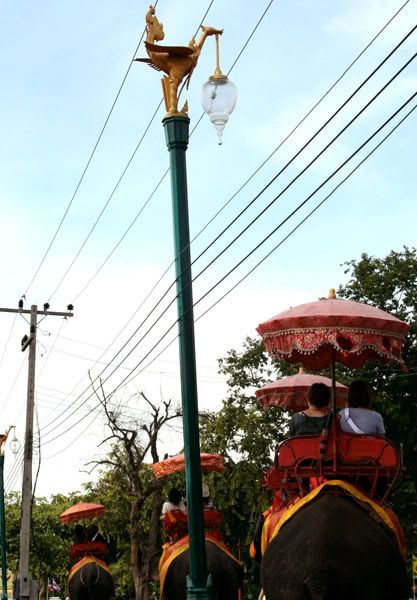 Of the two old capitals, Ayutthaya is the more popular, as it is only one hour north of Bangkok by train. The city's ruins are scattered throughout the city. Some are simple brick wats, now fairly rundown, and overgrown with the creeping roots of fig trees. Some wats are fortunate enough to be protected by their own grassy lawns, while others are now surrounded by busy intersections, where they're bathed in dust and smog. Ayutthaya's major sights are mainly visited by tour groups on day trips, so they are generally surrounded by clusters of brightly colored tour buses.
Of the two old capitals, Ayutthaya is the more popular, as it is only one hour north of Bangkok by train. The city's ruins are scattered throughout the city. Some are simple brick wats, now fairly rundown, and overgrown with the creeping roots of fig trees. Some wats are fortunate enough to be protected by their own grassy lawns, while others are now surrounded by busy intersections, where they're bathed in dust and smog. Ayutthaya's major sights are mainly visited by tour groups on day trips, so they are generally surrounded by clusters of brightly colored tour buses.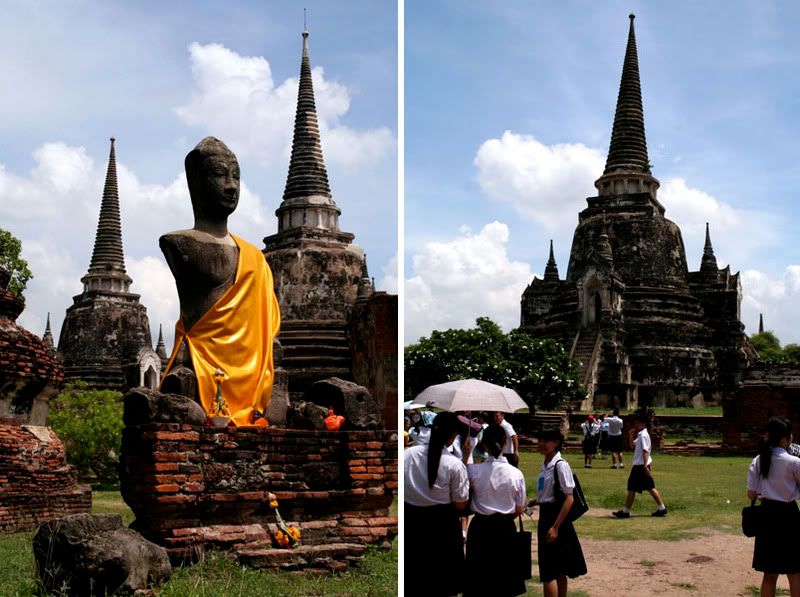 Several of the more impressive sites, like Wat Phra Mahatat and Wat Phra Si Sanphet, are located in a vast but populous complex in the center of town. Below towering stone chedis and ruins, stands are set up to sell souvenirs, postcards, and icy-cold cans of Fanta. Elephant tours depart from a small corral- when we visited there were nine or ten elephants standing chained side-by-side, shifting nervously on their feet. An audience of mainly Thai and Japanese tourists watched as one of the elephants performed tricks, such as standing awkwardly on top of an upturned barrel. Inside the walls of the wat, the scene was no less manic. There was a school tour on the day we visited, and the grounds were filled with groups of children playing and posing for photographs.
Several of the more impressive sites, like Wat Phra Mahatat and Wat Phra Si Sanphet, are located in a vast but populous complex in the center of town. Below towering stone chedis and ruins, stands are set up to sell souvenirs, postcards, and icy-cold cans of Fanta. Elephant tours depart from a small corral- when we visited there were nine or ten elephants standing chained side-by-side, shifting nervously on their feet. An audience of mainly Thai and Japanese tourists watched as one of the elephants performed tricks, such as standing awkwardly on top of an upturned barrel. Inside the walls of the wat, the scene was no less manic. There was a school tour on the day we visited, and the grounds were filled with groups of children playing and posing for photographs.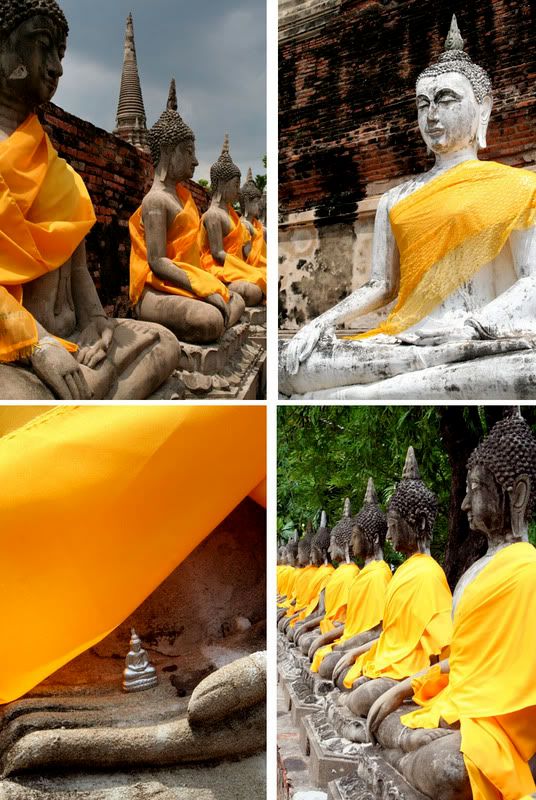 Though also popular with school-groups, the Wat Yai Chai Mongkol, located across the river, felt much quieter. Inside a brick wall perimeter lined with mango trees were a row of white faced Buddhas, each with a small amulet or votive in its elegant sculpted hand. The shady garden gave a sense of calm, even as we were surrounded by Thai students wanting to practice their English and take photos with us.
Though also popular with school-groups, the Wat Yai Chai Mongkol, located across the river, felt much quieter. Inside a brick wall perimeter lined with mango trees were a row of white faced Buddhas, each with a small amulet or votive in its elegant sculpted hand. The shady garden gave a sense of calm, even as we were surrounded by Thai students wanting to practice their English and take photos with us.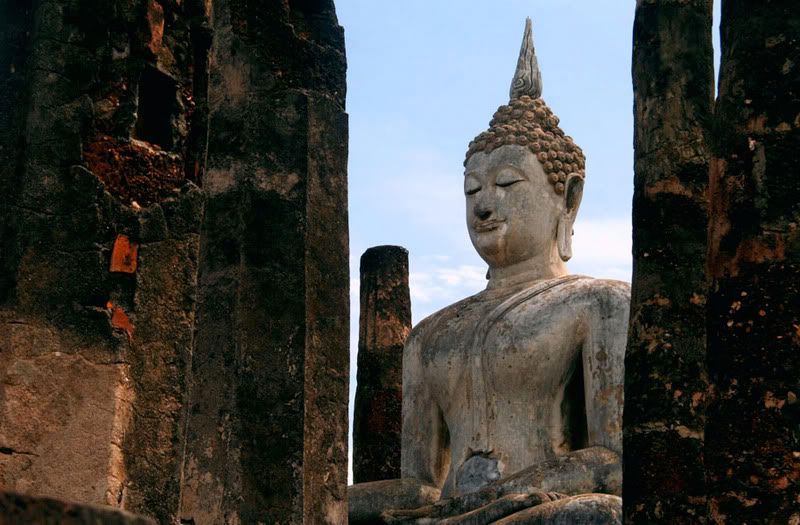 Sukhothai, located several hours further north, is a far different experience. Where the Ayutthaya ruins are located between apartments-blocks and shops and highways, the Sukhothai ruins are actually located some distance from the newer city development. And while the ruins are even more beautiful, and the art even more striking, not nearly as many people visit.
Sukhothai, located several hours further north, is a far different experience. Where the Ayutthaya ruins are located between apartments-blocks and shops and highways, the Sukhothai ruins are actually located some distance from the newer city development. And while the ruins are even more beautiful, and the art even more striking, not nearly as many people visit.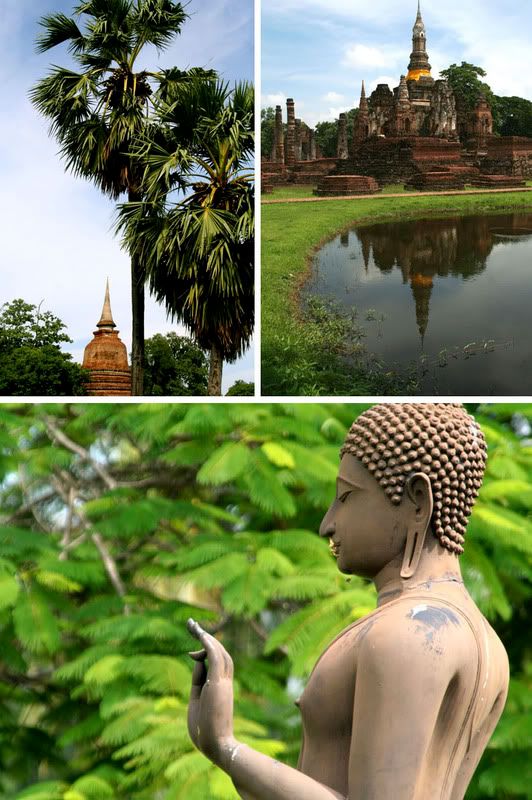 Not only is old city complex less crowded, but the site itself is designed to give a sense of calm and symmetry. Sukhothai was declared a world heritage site, so the grounds of the complex have been restored with the help of UNESCO. The vast gardens have been shaped with canals and planted with coconut palms and mango trees, and many of the ruins have been carefully restored. The waterways and ponds at Sukhothai were designed specifically to reflect the wats, so they offer a sense of balance to the crumbling ruins. Though the grounds of old Sukhothai were never empty, the crowds felt much less hurried than at Ayutthaya. Backpackers relaxed on shady lawns, and locals ate their lunch leisurely at waters edge. It created a calm environment, where there were no distractions from the beauty of the graceful ruins.
Not only is old city complex less crowded, but the site itself is designed to give a sense of calm and symmetry. Sukhothai was declared a world heritage site, so the grounds of the complex have been restored with the help of UNESCO. The vast gardens have been shaped with canals and planted with coconut palms and mango trees, and many of the ruins have been carefully restored. The waterways and ponds at Sukhothai were designed specifically to reflect the wats, so they offer a sense of balance to the crumbling ruins. Though the grounds of old Sukhothai were never empty, the crowds felt much less hurried than at Ayutthaya. Backpackers relaxed on shady lawns, and locals ate their lunch leisurely at waters edge. It created a calm environment, where there were no distractions from the beauty of the graceful ruins.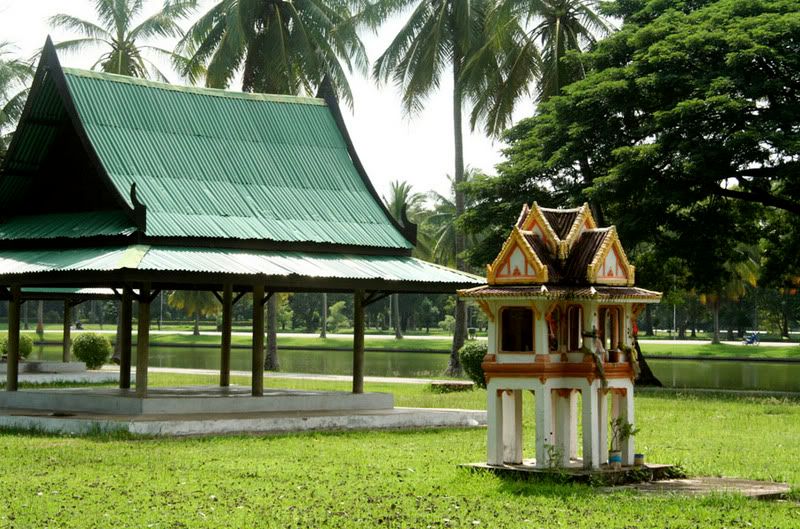
Monday, June 25, 2007
Photographing Khao Yai.
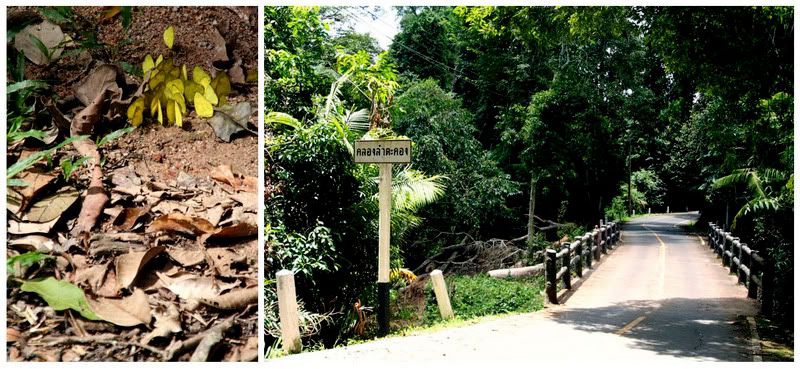 Leaving Bangkok last Sunday, Bordeaux and I headed north by train to Pak Chong, frontier town to Khao Yai National Park. After spending a night just of outside town, we took a public songthew to the Khao Yai park gate. There, we sat among our backpacks, and waited for a car to give us a lift in. The ranger at the gate kindly asked the driver of a pick-up for us; he nodded, so we hopped into the back of his truck. The journey into Khao Yai gave us a sense of what we'd see inside the park- unimaginably lush green towering forest, rising sharply from the edge of the asphalt road. The forest was beautiful and darkly mysterious, vines and stranglers swallowing tree-trunks and tangling into knots as they pushed up vertically. I had wanted to see the jungles of Southeast Asia for years, and this first taste didn't satisfy, but rather only managed to make me more intrigued and curious. Even the sudden downpour of steamy tropical rain couldn't distract me from studying the forest- I just pulled my cap lower, and held onto the truck tighter as I watched the green tangles enveloping me.
Leaving Bangkok last Sunday, Bordeaux and I headed north by train to Pak Chong, frontier town to Khao Yai National Park. After spending a night just of outside town, we took a public songthew to the Khao Yai park gate. There, we sat among our backpacks, and waited for a car to give us a lift in. The ranger at the gate kindly asked the driver of a pick-up for us; he nodded, so we hopped into the back of his truck. The journey into Khao Yai gave us a sense of what we'd see inside the park- unimaginably lush green towering forest, rising sharply from the edge of the asphalt road. The forest was beautiful and darkly mysterious, vines and stranglers swallowing tree-trunks and tangling into knots as they pushed up vertically. I had wanted to see the jungles of Southeast Asia for years, and this first taste didn't satisfy, but rather only managed to make me more intrigued and curious. Even the sudden downpour of steamy tropical rain couldn't distract me from studying the forest- I just pulled my cap lower, and held onto the truck tighter as I watched the green tangles enveloping me.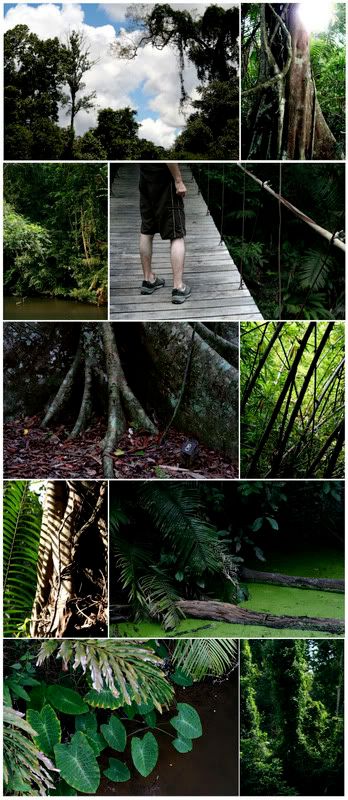 I've always been fascinated with jungles. They were not only the home of my favorite beasts, but in some way they represented all the darkness and danger and strangeness of the exotic world. So I was rather disappointed when I first traveled in Central America, and found that my photographs of jungles came out so poorly. As I found out, jungles aren't easy places to photograph. There are of course technical reasons for this, mainly the lack of light. There are also practical aspects that make it difficult for a photographer- the heat and sweat, and, on this trop, the constant battle against ground leeches climbing up my shoe. But there are other reasons, as well. To begin with, the forest is often just a mess of green, with few other colors standing out, so framing an interesting composition can be difficult. One option is to search for focal points- animals or flowers or landmarks- around which to structure a picture. But this rarely makes for an interesting photograph- the images come out like scientific stills of singular objects against a background of green. It's perhaps exactly because jungle have an aura of mystery that they're very difficult places to photograph. How do you capture the unknown forest though a medium that was developed to illuminate and illustrate? In the end, my decision was simply to stop trying to order my compositions. Instead, I tried to capture the disorder of the jungle through less planned out and framed shots. In the end, any order that resulted would be the forest's own, emerging in the lines of bamboo or the patterns of leaves.
I've always been fascinated with jungles. They were not only the home of my favorite beasts, but in some way they represented all the darkness and danger and strangeness of the exotic world. So I was rather disappointed when I first traveled in Central America, and found that my photographs of jungles came out so poorly. As I found out, jungles aren't easy places to photograph. There are of course technical reasons for this, mainly the lack of light. There are also practical aspects that make it difficult for a photographer- the heat and sweat, and, on this trop, the constant battle against ground leeches climbing up my shoe. But there are other reasons, as well. To begin with, the forest is often just a mess of green, with few other colors standing out, so framing an interesting composition can be difficult. One option is to search for focal points- animals or flowers or landmarks- around which to structure a picture. But this rarely makes for an interesting photograph- the images come out like scientific stills of singular objects against a background of green. It's perhaps exactly because jungle have an aura of mystery that they're very difficult places to photograph. How do you capture the unknown forest though a medium that was developed to illuminate and illustrate? In the end, my decision was simply to stop trying to order my compositions. Instead, I tried to capture the disorder of the jungle through less planned out and framed shots. In the end, any order that resulted would be the forest's own, emerging in the lines of bamboo or the patterns of leaves.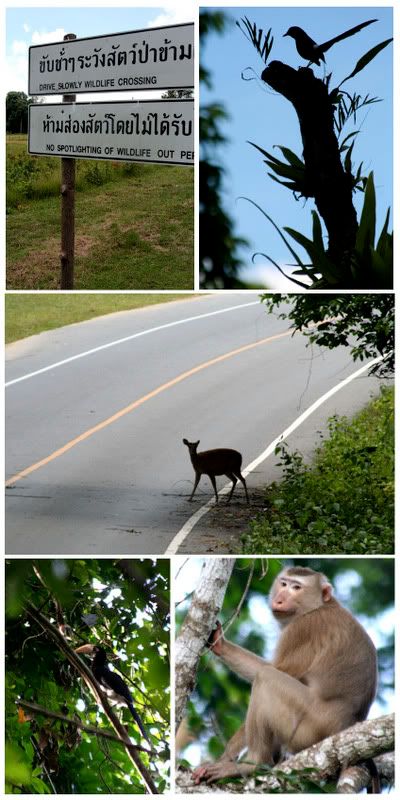 Photographing wildlife was just as difficult. We had come to Khao Yai expecting not to see much wildlife, but ended up being very lucky. Despite the number of incredible, strange creatures we saw, few sightings resulted in good photographs. The barking deer would dart into the forest if approached, flycatchers rarely waited in appropriate light, and macaques refused to sit still. While searching for our campsite on our first day at Khao Yai, Bordeaux and I were surrounded by the slow deep song of the gibbon. We stopped to listen, and noticed the movement of leaves in the trees nearby. Searching in the shadowy gaps between trees, we saw the silhouette of several gibbons swinging among branches. They were too quick and in too dark of forest to photograph, but the sight was beautiful- their strange, long arms swinging their bodies from one branch to another.
Photographing wildlife was just as difficult. We had come to Khao Yai expecting not to see much wildlife, but ended up being very lucky. Despite the number of incredible, strange creatures we saw, few sightings resulted in good photographs. The barking deer would dart into the forest if approached, flycatchers rarely waited in appropriate light, and macaques refused to sit still. While searching for our campsite on our first day at Khao Yai, Bordeaux and I were surrounded by the slow deep song of the gibbon. We stopped to listen, and noticed the movement of leaves in the trees nearby. Searching in the shadowy gaps between trees, we saw the silhouette of several gibbons swinging among branches. They were too quick and in too dark of forest to photograph, but the sight was beautiful- their strange, long arms swinging their bodies from one branch to another. 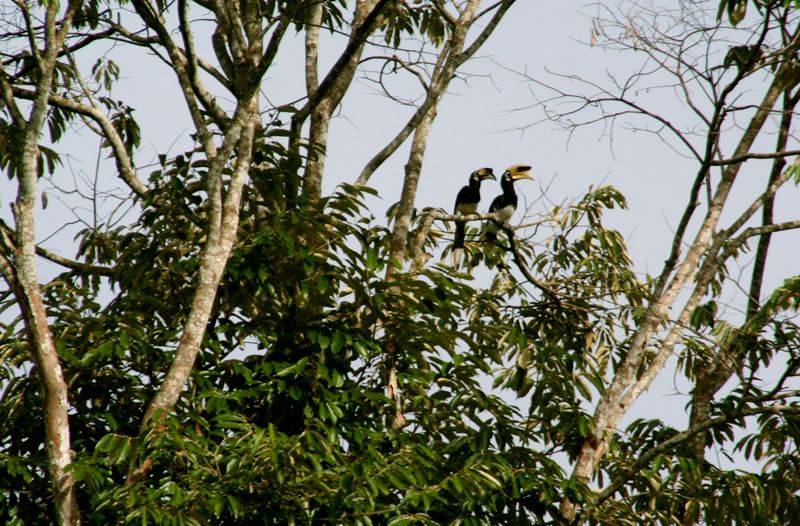 Just as beautiful and difficult to photograph were the park's hornbills. They're not shy birds- they chatter and fight noisily, jump around clumsily on branches, and flap loudly from one tree to another. But they roost so high that even with a zoom lens it's hard to get a very careful shot of them. We saw several pairs of Oriental Pied Hornbills, large black and white birds that fight incessantly in pairs. We watched them follow eachother around, flying from the height of one tree to the next. While crossing a bog one afternoon, we heard the loud flapping of wings overhead, and watched as a Great Hornbill passed over us, golden feathers flashing. It perched briefly on a distant tree, it's huge yellow casque shining brilliant, before taking off again.
Just as beautiful and difficult to photograph were the park's hornbills. They're not shy birds- they chatter and fight noisily, jump around clumsily on branches, and flap loudly from one tree to another. But they roost so high that even with a zoom lens it's hard to get a very careful shot of them. We saw several pairs of Oriental Pied Hornbills, large black and white birds that fight incessantly in pairs. We watched them follow eachother around, flying from the height of one tree to the next. While crossing a bog one afternoon, we heard the loud flapping of wings overhead, and watched as a Great Hornbill passed over us, golden feathers flashing. It perched briefly on a distant tree, it's huge yellow casque shining brilliant, before taking off again. The greatest opportunity for seeing wildlife, the night lighting, was also the worst for photography. For 40 baht (about one dollar), you sit with five or ten other people in the back of a moving truck, watching as a guide flashes a spotlight around the jungle. It was awesome. The jungle is beautiful at night, even more obscure and elusive than in the day, with just the nearest leaves and tree-trunks emerging from darkness as we passed through. We saw an incredible number of animals on the first night drive- sambar and barking deer out grazing, civets enjoying a late meal, and a dhole (Asian wild dog) hiding among the grasses. When we returned to our camp from the first night drive, their was a Malayan porcupine waiting for us. As we moved toward our tent it walked past us, foot-long quills swaying. We were also lucky enough to have two elephant sightings, neither of which produced a good photograph. On the second night we saw a young bull elephant that was apparently angered by the light from our truck- it charged at us, so we quickly sped off without taking any photos. The other elephant was peacefully browsing, but as we stopped behind it, it put down its trunk and slipped into the forest, disappearing between vines and branches more effectively than one would think any elephant could.
The greatest opportunity for seeing wildlife, the night lighting, was also the worst for photography. For 40 baht (about one dollar), you sit with five or ten other people in the back of a moving truck, watching as a guide flashes a spotlight around the jungle. It was awesome. The jungle is beautiful at night, even more obscure and elusive than in the day, with just the nearest leaves and tree-trunks emerging from darkness as we passed through. We saw an incredible number of animals on the first night drive- sambar and barking deer out grazing, civets enjoying a late meal, and a dhole (Asian wild dog) hiding among the grasses. When we returned to our camp from the first night drive, their was a Malayan porcupine waiting for us. As we moved toward our tent it walked past us, foot-long quills swaying. We were also lucky enough to have two elephant sightings, neither of which produced a good photograph. On the second night we saw a young bull elephant that was apparently angered by the light from our truck- it charged at us, so we quickly sped off without taking any photos. The other elephant was peacefully browsing, but as we stopped behind it, it put down its trunk and slipped into the forest, disappearing between vines and branches more effectively than one would think any elephant could.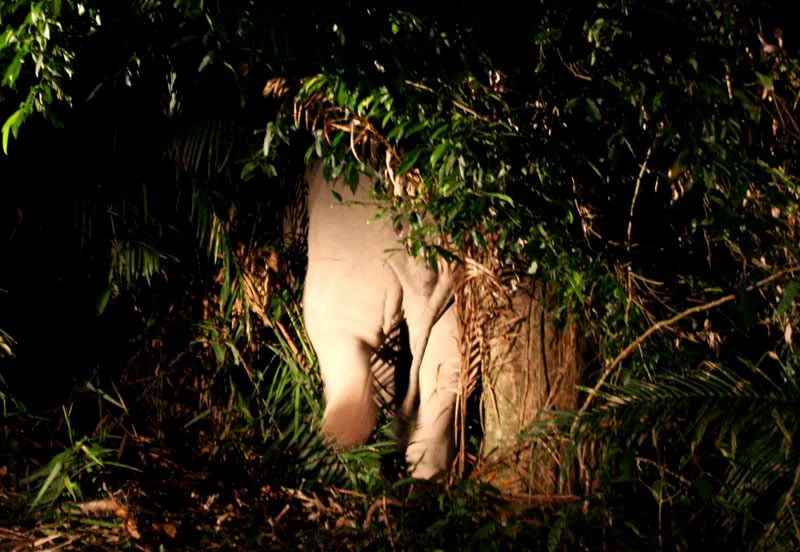
Themes:
Adventure,
jungles,
photography,
Southeast Asia,
Thailand,
Wildlife
Sunday, June 17, 2007
Sripoom.
 Much better for a local cup of coffee is Sripoom, on Thanon Chakra Bonse. Located between touristy and studenty neighborhoods, the place gets an even mix of travelers and young locals. The interior is hip- with lots of gaudy colors and prints. Above the seats hangs a long black and white photograph of a Bangkok street-front, complete with traffic and the mess of telephone wires. The coffee is good, as they serve the best lattes I got in Bangkok. The drink menu at night might be even better- they serve a range of bright fruity cocktails themed to the pleasures of Bangkok.
Much better for a local cup of coffee is Sripoom, on Thanon Chakra Bonse. Located between touristy and studenty neighborhoods, the place gets an even mix of travelers and young locals. The interior is hip- with lots of gaudy colors and prints. Above the seats hangs a long black and white photograph of a Bangkok street-front, complete with traffic and the mess of telephone wires. The coffee is good, as they serve the best lattes I got in Bangkok. The drink menu at night might be even better- they serve a range of bright fruity cocktails themed to the pleasures of Bangkok.
Themes:
Bangkok,
Bangkok Coffee Shops,
Coffee,
Thai Food and Coffee,
Thailand
Coffee in Bangkok.
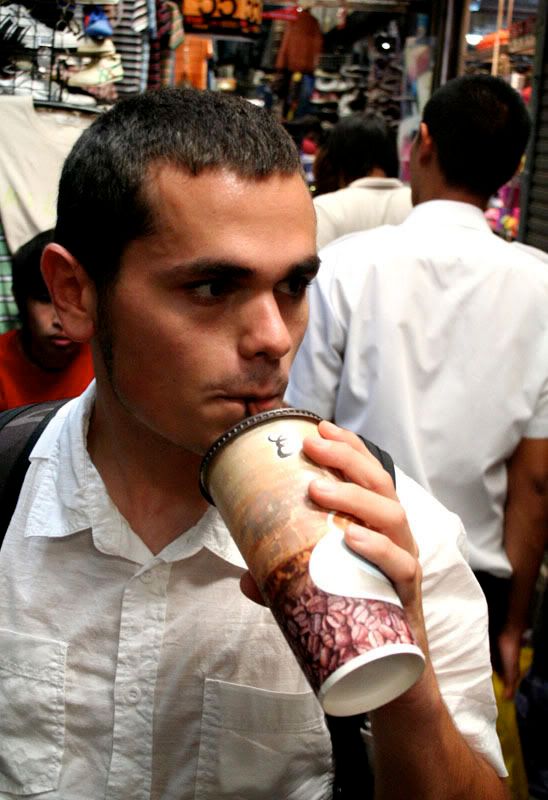 One of the things I worried about when coming to Southeast Asia was the possible lack of good coffee. I've developed a pretty strong dependency, but aside from that, I love the taste of coffee, and getting coffee is among my favorite leisure activities. Thankfully, getting good coffee in Bangkok has not been a problem.
One of the things I worried about when coming to Southeast Asia was the possible lack of good coffee. I've developed a pretty strong dependency, but aside from that, I love the taste of coffee, and getting coffee is among my favorite leisure activities. Thankfully, getting good coffee in Bangkok has not been a problem. 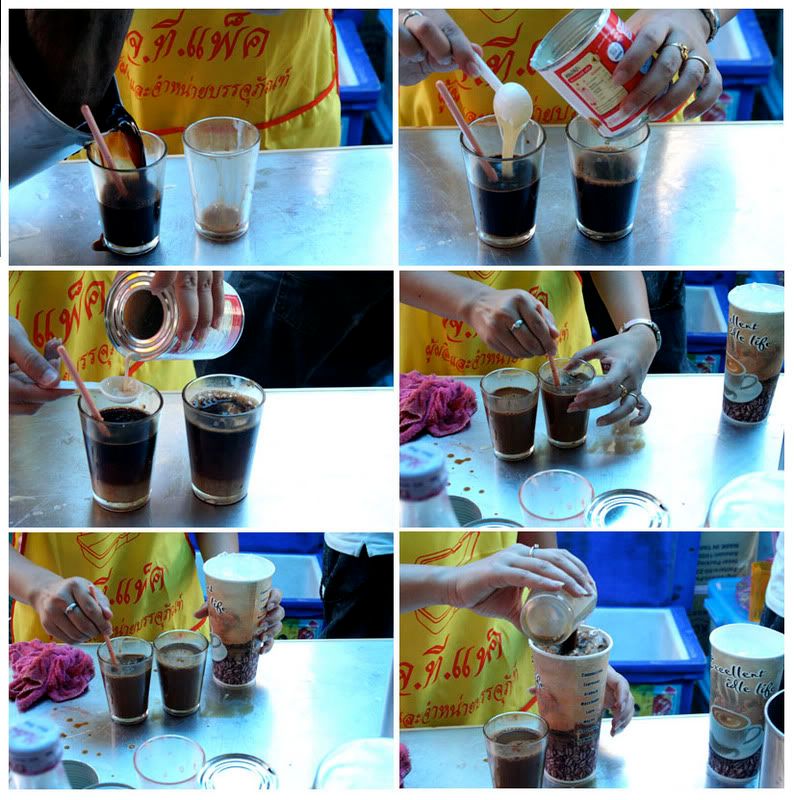 The most common coffee in Bangkok is the Thai iced coffee, which can be found at cafes, restaurants, and stands located out on the street. Since seeking out good street-food is another hobby of mine, this is an added bonus. In some places, Thai iced coffee is served in a plastic bag, but so far I've only had it in tall generic paper cups. Thai iced coffee is incredibly sweet and rich, with a smooth texture resulting from the combination of sweetened and condensed milk mixed in with the coffee. The coffee itself is admittedly very weak, especially when thinned out and served over ice, but it's enough to meet my cravings, with the added bonus of soothing Bangkok's heat.
The most common coffee in Bangkok is the Thai iced coffee, which can be found at cafes, restaurants, and stands located out on the street. Since seeking out good street-food is another hobby of mine, this is an added bonus. In some places, Thai iced coffee is served in a plastic bag, but so far I've only had it in tall generic paper cups. Thai iced coffee is incredibly sweet and rich, with a smooth texture resulting from the combination of sweetened and condensed milk mixed in with the coffee. The coffee itself is admittedly very weak, especially when thinned out and served over ice, but it's enough to meet my cravings, with the added bonus of soothing Bangkok's heat.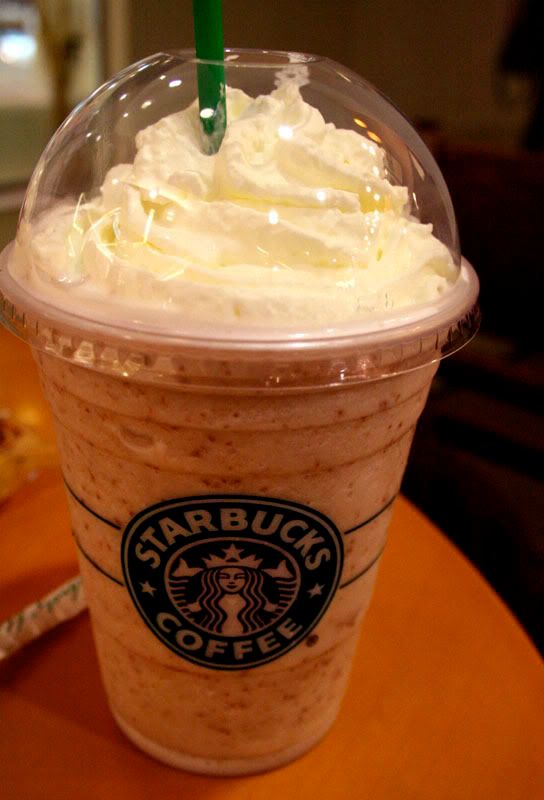 As Bangkok is an extremely cosmopolitan city, American Style lattes and European espressos are not hard to come by. There are numerous tourist coffee shops and student cafes that sell good coffee, and of course, the globally swelling Starbucks. When traveling in the Middle East, I developed the habit of going into Starbucks whenever I visited a new country. Coffee in the Middle East was amazing, so it wasn't out of lack- rather it was to see the ways that the American chain is adapted to fit into different climates. So far I've only see Starbucks in two areas in Bangkok- next to a McDonalds at the Western tourist oriented Khao San Road, and at the exclusive shopping malls of Siam. Bordeaux and I visited one at Siam Paragon, a label-heavy shopping center in Siam. The main draw for me was the posters outside, which showed frappucinos with one of my favorite flavors: red bean. They were surprisingly good- with the perfect offbeat redbean flavor, and vaguely nutty texture.
As Bangkok is an extremely cosmopolitan city, American Style lattes and European espressos are not hard to come by. There are numerous tourist coffee shops and student cafes that sell good coffee, and of course, the globally swelling Starbucks. When traveling in the Middle East, I developed the habit of going into Starbucks whenever I visited a new country. Coffee in the Middle East was amazing, so it wasn't out of lack- rather it was to see the ways that the American chain is adapted to fit into different climates. So far I've only see Starbucks in two areas in Bangkok- next to a McDonalds at the Western tourist oriented Khao San Road, and at the exclusive shopping malls of Siam. Bordeaux and I visited one at Siam Paragon, a label-heavy shopping center in Siam. The main draw for me was the posters outside, which showed frappucinos with one of my favorite flavors: red bean. They were surprisingly good- with the perfect offbeat redbean flavor, and vaguely nutty texture.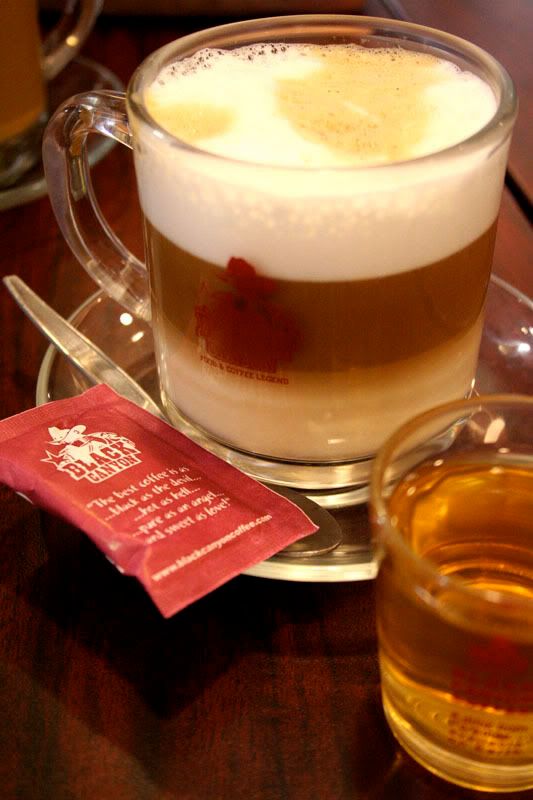 Bordeaux and I searched out Black Canyon Coffee, a Thai chain that's been competing locally with Starbucks. We finally found on, inside Siam Center shopping mall. The experience was a little disappointing. The menu seemed more oriented toward meals than coffee, and the very stylish interior of dark wood and polished metal was marred by tacky elements, like the bubbling fountain in the corner and the cheesy platitudes in the menu. Still, the coffee menu was extensive, and the latte was good, so I can see why Black Canyon Coffee has been able to compete with the global giant.
Bordeaux and I searched out Black Canyon Coffee, a Thai chain that's been competing locally with Starbucks. We finally found on, inside Siam Center shopping mall. The experience was a little disappointing. The menu seemed more oriented toward meals than coffee, and the very stylish interior of dark wood and polished metal was marred by tacky elements, like the bubbling fountain in the corner and the cheesy platitudes in the menu. Still, the coffee menu was extensive, and the latte was good, so I can see why Black Canyon Coffee has been able to compete with the global giant.Editors Note: (October 14, 2007) I wrote this entry when I had been in Bangkok for less than a week, so I have a few corrections or qualifications. I've since grown a lot more fond of Black Canyon- most of the branches lack the oddly tacky elements of the location in the Siam Center. Furthermore, most outlets don't even offer food, so most places feature a menu geared primarily toward coffee drinks. I still have some reservations about them- they tend to favor really cheesy slogans and phrases in their marketing- but they make a number of delicious coffee drinks. As for Starbucks, there are branches all over the city- not just in the two neighborhoods I mentioned. And sadly, the red bean frappucino may have only been temporary.
Friday, June 15, 2007
Arrival in Bangkok.
 I was prepared not to like Bangkok. I'd heard terrible reports about the filth, the noise, the traffic and the hordes of tacky Australians with dreads. I was surprised, then, to find out what a beautiful city it is. I arrived by plane just before six in the morning. As we lowered down toward the airport, we curved above the city, a sprawling field of skyscrapers and wats sliced through with a curving river, all barely illuminated in the early morning haze.
I was prepared not to like Bangkok. I'd heard terrible reports about the filth, the noise, the traffic and the hordes of tacky Australians with dreads. I was surprised, then, to find out what a beautiful city it is. I arrived by plane just before six in the morning. As we lowered down toward the airport, we curved above the city, a sprawling field of skyscrapers and wats sliced through with a curving river, all barely illuminated in the early morning haze. On the ground, the city is even more amazing. Stepping out of our guesthouse into the sticky air, we walk on cracked tree lined sidewalks crowded with foodstalls. Lush wat complexes cut between concrete apartment blocks, gold spires lifting out of leafy gardens. The streets are noisy, dirty, polluted and amazingly colorful, result of the motorbikes, airbrushed buses, pink taxis and green tuk tuks that swarm them.
On the ground, the city is even more amazing. Stepping out of our guesthouse into the sticky air, we walk on cracked tree lined sidewalks crowded with foodstalls. Lush wat complexes cut between concrete apartment blocks, gold spires lifting out of leafy gardens. The streets are noisy, dirty, polluted and amazingly colorful, result of the motorbikes, airbrushed buses, pink taxis and green tuk tuks that swarm them.
Tuesday, June 12, 2007
Pretoria Victorious.
 Despite having lived in South Africa for a year, I had never been to Pretoria. The closest I had come was passing through the city at night on a Greyhound bus on the way to Zimbabwe. So on this trip to South Africa, I very conscientiously added Pretoria to my itinerary. However, after finally visiting, I suppose I can see why I never made the effort to visit in the past.
Despite having lived in South Africa for a year, I had never been to Pretoria. The closest I had come was passing through the city at night on a Greyhound bus on the way to Zimbabwe. So on this trip to South Africa, I very conscientiously added Pretoria to my itinerary. However, after finally visiting, I suppose I can see why I never made the effort to visit in the past. On my way up from Johannesburg, I stopped at the Voortrekker monument. I have a fascination with Afrikaner culture, and since I'm still working on my ethnography on Afrikaner nationalism, I considered this to be a form of research. Following the somewhat rough, hand drawn map I had copied from the internet, I was a little worried that I might not be able to find it. This turned out to be a rather ridiculous thought, I realized, as Afrikaners of course love to make their monuments enormously prominent- rising over the trees on a distant green hill was the Voortrekker Monument, a thick, solid tower in sandstone. After paying a rather exorbitant fee (an entrance charge and a car fee) and parking in the nearly empty lot, I climbed the steps up to the tower's base. On the way I passed two restrooms, carved to look like bulky ox wagons. Unlike the equally phallic Taal monument, which is graceful and streamlined if rather concrete, the Voortrekker monument is rather squat and inelegant. The plaque at the base of the monument stated that it was built in the Art Deco style, but, squinting up at it, I couldn't detect any signs of this. Maybe they meant Apartheid deco? Afrikaner deco? Inside the darkened inner-chamber of the monument were a series of artworks depicting Afrikaner history: the Voortrekkers battle savage Africans, make pacts with God, and look out over barbarous lands with optimism.
On my way up from Johannesburg, I stopped at the Voortrekker monument. I have a fascination with Afrikaner culture, and since I'm still working on my ethnography on Afrikaner nationalism, I considered this to be a form of research. Following the somewhat rough, hand drawn map I had copied from the internet, I was a little worried that I might not be able to find it. This turned out to be a rather ridiculous thought, I realized, as Afrikaners of course love to make their monuments enormously prominent- rising over the trees on a distant green hill was the Voortrekker Monument, a thick, solid tower in sandstone. After paying a rather exorbitant fee (an entrance charge and a car fee) and parking in the nearly empty lot, I climbed the steps up to the tower's base. On the way I passed two restrooms, carved to look like bulky ox wagons. Unlike the equally phallic Taal monument, which is graceful and streamlined if rather concrete, the Voortrekker monument is rather squat and inelegant. The plaque at the base of the monument stated that it was built in the Art Deco style, but, squinting up at it, I couldn't detect any signs of this. Maybe they meant Apartheid deco? Afrikaner deco? Inside the darkened inner-chamber of the monument were a series of artworks depicting Afrikaner history: the Voortrekkers battle savage Africans, make pacts with God, and look out over barbarous lands with optimism.  I was unsure of what else I should visit in Pretoria, so I checked out the usually helpful Rough Guide website. The only real attraction they suggested was Church Square, so I decided to head there after leaving the Voortrekker Monument. Following a series of one way streets into the center of town, I easily reached Church Square. Getting out of my car, I immediately had a confusing interaction with a heavily scarred man, who wanted me to pay him to put money in the parking meter for me. The square was hardly the cosmopolitan center that the Rough Guide made it seem; instead it was a simple park surrounded by quiet office complexes, and a few impresive old governmental buildings. However, it had an oddly bucolic charm for being at the center of South Africa's capital; there were crowds of people lying on the grassy lawn, enjoying snacks sold from ice cream trucks and fruit stands. Following another suggestion from Rough Guide, I checked out Cafe Riche, located on a corner of Church Square. It turned out to be a rather dull European style espresso bar with turn-of-the-century fixtures and a stale coffee smell. After looking around the area for a bit, I found the much more appealing Tribeca Cafe. Set between tall buildings and under a canopy of trees on a side street, Tribeca Cafe offered relief from the bleaching winter sun. I sat near the fountain outside, enjoying a honey nut latte, and watching the traffic pass by.
I was unsure of what else I should visit in Pretoria, so I checked out the usually helpful Rough Guide website. The only real attraction they suggested was Church Square, so I decided to head there after leaving the Voortrekker Monument. Following a series of one way streets into the center of town, I easily reached Church Square. Getting out of my car, I immediately had a confusing interaction with a heavily scarred man, who wanted me to pay him to put money in the parking meter for me. The square was hardly the cosmopolitan center that the Rough Guide made it seem; instead it was a simple park surrounded by quiet office complexes, and a few impresive old governmental buildings. However, it had an oddly bucolic charm for being at the center of South Africa's capital; there were crowds of people lying on the grassy lawn, enjoying snacks sold from ice cream trucks and fruit stands. Following another suggestion from Rough Guide, I checked out Cafe Riche, located on a corner of Church Square. It turned out to be a rather dull European style espresso bar with turn-of-the-century fixtures and a stale coffee smell. After looking around the area for a bit, I found the much more appealing Tribeca Cafe. Set between tall buildings and under a canopy of trees on a side street, Tribeca Cafe offered relief from the bleaching winter sun. I sat near the fountain outside, enjoying a honey nut latte, and watching the traffic pass by.
Monday, June 11, 2007
Winter in Egoli
Winter in Egoli
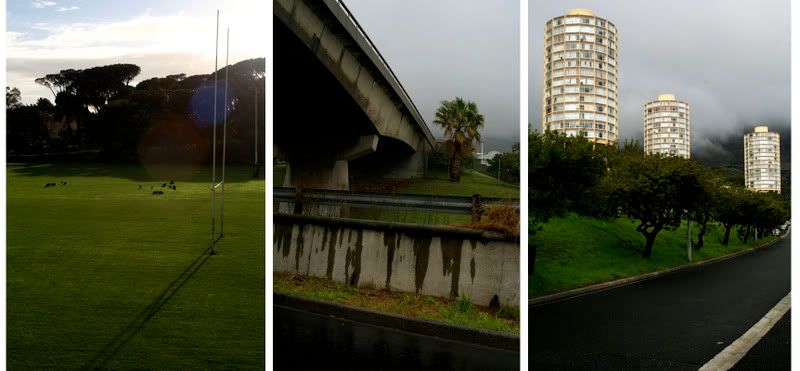 Cape Town, in winter, is wet. Grey clouds, heavy with cold rain, roll over Table Mountain and hang low over the city. Storms stain the roads shiny black. Lawns become so lush that every blade of grass drips with green.
Cape Town, in winter, is wet. Grey clouds, heavy with cold rain, roll over Table Mountain and hang low over the city. Storms stain the roads shiny black. Lawns become so lush that every blade of grass drips with green.
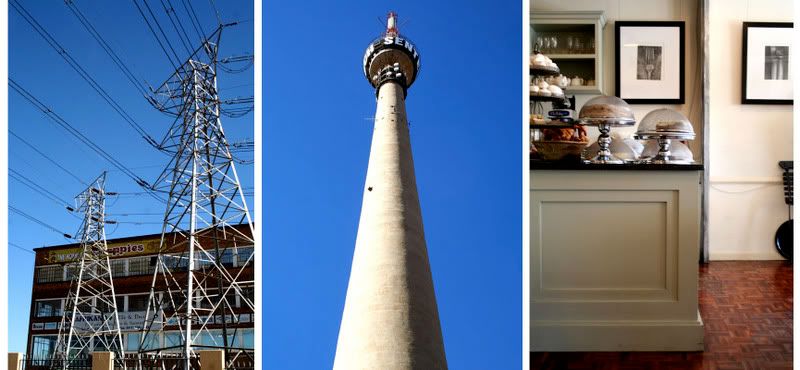 Johannesburg, in winter, dries out. Egoli lives up to it's name- place of gold- as the grass turns crisp and becomes golden, standing out brilliantly against the stark cloudless sky. The sky becomes overwhelming, so harsh that it reflects in blue hues in the concrete and brick of the city. To escape the cold, I had coffee in Melville at Service Station, my favorite coffee shop in Johannesburg (though that might not mean much as, admittedly, I know next to nothing of Johannesburg).
Johannesburg, in winter, dries out. Egoli lives up to it's name- place of gold- as the grass turns crisp and becomes golden, standing out brilliantly against the stark cloudless sky. The sky becomes overwhelming, so harsh that it reflects in blue hues in the concrete and brick of the city. To escape the cold, I had coffee in Melville at Service Station, my favorite coffee shop in Johannesburg (though that might not mean much as, admittedly, I know next to nothing of Johannesburg).
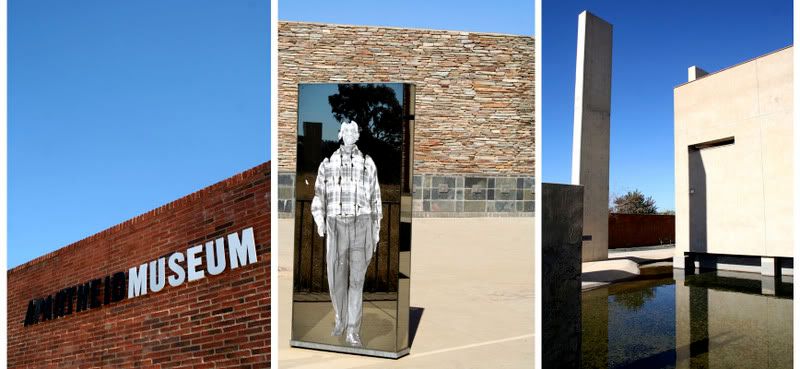 Following directional signs through the city, I eventually reached the Apartheid Museum. I pulled under the turreted entrance arch, sign reading: "Gold Reef City Theme Park and Casino- and Apartheid Museum." Walking from my car to the entrance, I was unsettled by the sound of screams- a disturbing sound installation meant to evoke the horrors of apartheid?- until I realized it was coming from the roller coaster at the amusement park that shares the property with the Apartheid Museum. The museum itself was designed a little like a theme park, with separate entrances for whites and non-whites meant to evoke the racial segregation. The exhibits curved through chainmetal and brick, past photos of domestic workers and Apartheid's architects. The archival video footage was particularly interesting. At a section on Afrikaner nationalism, they showed a 1930s film made to chronicle South Africa's history. Ships pulled into Table Bay, and a gallant Van Riebeek was greeted on shore by a group of kneeling, worshipping khoi-khoi. Another room featured footage of the ultimate right-wing reaction to the fall of apartheid, which manifested itself mainly in obese men dressing themselves in khaki and forming a militia. The museum was designed to tell two stories at once; of a people fighting and praying and dying for freedom, and of a group terrified to lose the way of life they felt they had earned.
Following directional signs through the city, I eventually reached the Apartheid Museum. I pulled under the turreted entrance arch, sign reading: "Gold Reef City Theme Park and Casino- and Apartheid Museum." Walking from my car to the entrance, I was unsettled by the sound of screams- a disturbing sound installation meant to evoke the horrors of apartheid?- until I realized it was coming from the roller coaster at the amusement park that shares the property with the Apartheid Museum. The museum itself was designed a little like a theme park, with separate entrances for whites and non-whites meant to evoke the racial segregation. The exhibits curved through chainmetal and brick, past photos of domestic workers and Apartheid's architects. The archival video footage was particularly interesting. At a section on Afrikaner nationalism, they showed a 1930s film made to chronicle South Africa's history. Ships pulled into Table Bay, and a gallant Van Riebeek was greeted on shore by a group of kneeling, worshipping khoi-khoi. Another room featured footage of the ultimate right-wing reaction to the fall of apartheid, which manifested itself mainly in obese men dressing themselves in khaki and forming a militia. The museum was designed to tell two stories at once; of a people fighting and praying and dying for freedom, and of a group terrified to lose the way of life they felt they had earned.
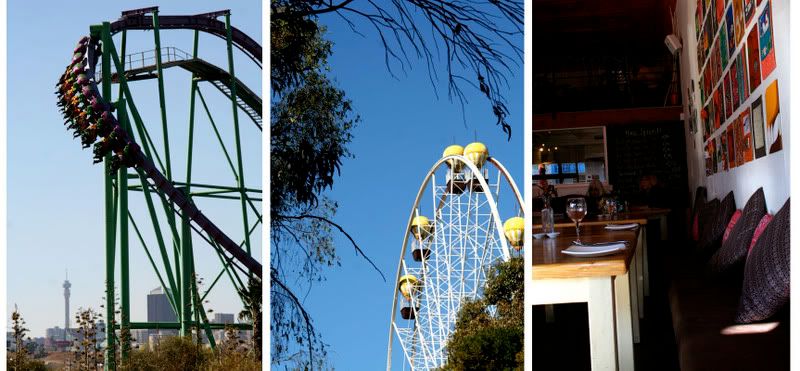 Leaving the Apartheid Museum, I looked out at the city skyline through the rides at Gold Reef City. I walked through the parking lot at Gold Reef City, which was of course much more full than the parking lot at the Apartheid Museum. It reminded me of something I had read in the apartheid museum: that in the face of apartheid, most people, white and black, chose to simply go on living, and to make the best of it that they could. Looking at the plaster statues of miners and crowds of children, I opted not to go to the themepark, but chose instead to pursue my own playground. I headed back to Melville, for lunch at the stylish 7th street cafe, Loft.
Leaving the Apartheid Museum, I looked out at the city skyline through the rides at Gold Reef City. I walked through the parking lot at Gold Reef City, which was of course much more full than the parking lot at the Apartheid Museum. It reminded me of something I had read in the apartheid museum: that in the face of apartheid, most people, white and black, chose to simply go on living, and to make the best of it that they could. Looking at the plaster statues of miners and crowds of children, I opted not to go to the themepark, but chose instead to pursue my own playground. I headed back to Melville, for lunch at the stylish 7th street cafe, Loft.
 Cape Town, in winter, is wet. Grey clouds, heavy with cold rain, roll over Table Mountain and hang low over the city. Storms stain the roads shiny black. Lawns become so lush that every blade of grass drips with green.
Cape Town, in winter, is wet. Grey clouds, heavy with cold rain, roll over Table Mountain and hang low over the city. Storms stain the roads shiny black. Lawns become so lush that every blade of grass drips with green. Johannesburg, in winter, dries out. Egoli lives up to it's name- place of gold- as the grass turns crisp and becomes golden, standing out brilliantly against the stark cloudless sky. The sky becomes overwhelming, so harsh that it reflects in blue hues in the concrete and brick of the city. To escape the cold, I had coffee in Melville at Service Station, my favorite coffee shop in Johannesburg (though that might not mean much as, admittedly, I know next to nothing of Johannesburg).
Johannesburg, in winter, dries out. Egoli lives up to it's name- place of gold- as the grass turns crisp and becomes golden, standing out brilliantly against the stark cloudless sky. The sky becomes overwhelming, so harsh that it reflects in blue hues in the concrete and brick of the city. To escape the cold, I had coffee in Melville at Service Station, my favorite coffee shop in Johannesburg (though that might not mean much as, admittedly, I know next to nothing of Johannesburg). Following directional signs through the city, I eventually reached the Apartheid Museum. I pulled under the turreted entrance arch, sign reading: "Gold Reef City Theme Park and Casino- and Apartheid Museum." Walking from my car to the entrance, I was unsettled by the sound of screams- a disturbing sound installation meant to evoke the horrors of apartheid?- until I realized it was coming from the roller coaster at the amusement park that shares the property with the Apartheid Museum. The museum itself was designed a little like a theme park, with separate entrances for whites and non-whites meant to evoke the racial segregation. The exhibits curved through chainmetal and brick, past photos of domestic workers and Apartheid's architects. The archival video footage was particularly interesting. At a section on Afrikaner nationalism, they showed a 1930s film made to chronicle South Africa's history. Ships pulled into Table Bay, and a gallant Van Riebeek was greeted on shore by a group of kneeling, worshipping khoi-khoi. Another room featured footage of the ultimate right-wing reaction to the fall of apartheid, which manifested itself mainly in obese men dressing themselves in khaki and forming a militia. The museum was designed to tell two stories at once; of a people fighting and praying and dying for freedom, and of a group terrified to lose the way of life they felt they had earned.
Following directional signs through the city, I eventually reached the Apartheid Museum. I pulled under the turreted entrance arch, sign reading: "Gold Reef City Theme Park and Casino- and Apartheid Museum." Walking from my car to the entrance, I was unsettled by the sound of screams- a disturbing sound installation meant to evoke the horrors of apartheid?- until I realized it was coming from the roller coaster at the amusement park that shares the property with the Apartheid Museum. The museum itself was designed a little like a theme park, with separate entrances for whites and non-whites meant to evoke the racial segregation. The exhibits curved through chainmetal and brick, past photos of domestic workers and Apartheid's architects. The archival video footage was particularly interesting. At a section on Afrikaner nationalism, they showed a 1930s film made to chronicle South Africa's history. Ships pulled into Table Bay, and a gallant Van Riebeek was greeted on shore by a group of kneeling, worshipping khoi-khoi. Another room featured footage of the ultimate right-wing reaction to the fall of apartheid, which manifested itself mainly in obese men dressing themselves in khaki and forming a militia. The museum was designed to tell two stories at once; of a people fighting and praying and dying for freedom, and of a group terrified to lose the way of life they felt they had earned. Leaving the Apartheid Museum, I looked out at the city skyline through the rides at Gold Reef City. I walked through the parking lot at Gold Reef City, which was of course much more full than the parking lot at the Apartheid Museum. It reminded me of something I had read in the apartheid museum: that in the face of apartheid, most people, white and black, chose to simply go on living, and to make the best of it that they could. Looking at the plaster statues of miners and crowds of children, I opted not to go to the themepark, but chose instead to pursue my own playground. I headed back to Melville, for lunch at the stylish 7th street cafe, Loft.
Leaving the Apartheid Museum, I looked out at the city skyline through the rides at Gold Reef City. I walked through the parking lot at Gold Reef City, which was of course much more full than the parking lot at the Apartheid Museum. It reminded me of something I had read in the apartheid museum: that in the face of apartheid, most people, white and black, chose to simply go on living, and to make the best of it that they could. Looking at the plaster statues of miners and crowds of children, I opted not to go to the themepark, but chose instead to pursue my own playground. I headed back to Melville, for lunch at the stylish 7th street cafe, Loft.
Themes:
Africa,
Cape Town,
Johannesburg,
museums,
South Africa
Friday, June 08, 2007
Top Ten Cape Town Coffeeshops.
 1. Vida e Caffe, Kloof Street, City Bowl
1. Vida e Caffe, Kloof Street, City BowlI'm willing to put up with the pretensions of a coffeeshop that has its own name-dropping magazine for the quality of the coffee at Vida. They do have something to be arrogant about, I guess, as their sleek, stylish interiors of cork and zebrawood got them featured in Wallpaper* as the hippest coffee chain in the world. Unfortunately, Vida has lately made a habit of opening in soulless shopping malls and bland business parks, which is why I name the Kloof Street location specifically. Its crowd is always a good mix of artfully dressed students from the nearby Michaelis art school, stylish Gardens locals, and business men and women in suits.
2. Empire Cafe, Muizenburg
Named for the long derelict Empite Theatre, this two-story cafe sits quietly at the end of a cul-de-sac, just across the train tracks from the crumbling Muizenburg seafront. Mid-morning is the best time to come, to take a long brunch, or just for coffee and one of the baked goods on offer downstairs. Though the food is stellar, and the baked goods are delicious, it's the atmosphere in this coffeeshop that sets it apart. From the second floor, you can look out past Victorian shopfronts to the deep blue water of Vals Baai. Trains rumble past as you enjoy a leisurely meal, while wet-suit clad surfers stop in, dripping saltwater on the floor.
 3. Love Birds Cafe, Street, City Bowl
3. Love Birds Cafe, Street, City BowlSomething about this coffeeshop always intimidated me, and so I left South Africa at the end of 2006 without ever having gone in. Thankfully, I finally made a visit on this trip. The interior was brilliant, spare, with a simple wooden table acting as bakery counter. Unusual elements, like chandeliers shapes like swans and seat covers embroidered with fairytale illustrations of wolves, blend perfectly with more homey touches, like the long communal wooden tables that make you feel like you're eating in a farmhouse. And best of all, my breakfast, which was served in a range of quirky bird themed dishes, was phenomenal. The house mix coffee was rich and flavorful, and the scone I ordered, which was filled with sultanas, nuts, and melting chocolate pieces, was undoubtedly the best I've ever eaten.
4. Afro Cafe, Between Long and Greenmarket Square, City Bowl
As a student of African Studies, I feel it's my duty to indulge in ridiculous Afrocentric style now and then. Afro Cafe is like the spatial realization of a hip Afrocentrism, with wax-cloth tablecloths, chandeliers made from recycled plastic, and a mural of a black mermaid looking out over Table Bay. The menu lives up to the interior, with a range of coffees and teas that reflect the flavors and tastes of the continent.
 5. Cafe Neo, Mouille Point
5. Cafe Neo, Mouille PointThe logo for Cafe Neo is a turquoise blue evil-eye, which hints to the Greek character of this little cafe across from the Mouille Point lighthouse. The interior, a long curving space, is a mix of Mediterranian domesticity and modernist design, with bleached wood tables and black and white family photos. You can sit at one of the small ocean-view tables that spill out onto the deck, or you can sat with your laptop at the long communal worker's tables. The menu, written on the wall-sized blackboard, includes breakfast, large meals, and offerings from the Middle Eastern deli. Though the coffee list is extensive, the best drink is, understandably, the Greek coffee, which comes thick and strong, with a glass of water to cleanse your mouth in order to fully appreciate the coffee's flavor.
6. Portobello, Long Street, City Bowl
One of the best things about Cape Town is that because of places like Portobello, it's a cheap city for vegetarians to eat well. The menu offers all-veggie sandwiches, soups and salads, and the coffee menu is extensive. The interior is bohemian without being grungy, and there's usually a variety of local art on show. The loft upstairs is the perfect setting for a quiet lunch- though waitresses have a habit of forgetting they have customers up there.
 7. Olympia Cafe, Kalk Bay
7. Olympia Cafe, Kalk BayOlympia Cafe may be a sign of Kalk Bay's gentrification, but at least it makes the process livable. Though a few signs around the door proclaim a fondness for "hippies," the interior is thankfully clean and spare, with an elegant design. Instead of looking at the 'art' that hangs on the walls (often local amateur photographers playing with photoshop), turn instead to face the stacks of baked goods; beautifully crafted crossaints, brownies, and breads. The muted color in the faded blue walls balances perfectly with the hazy stretch of ocean that sits opposite Olympia's glass windows.
8. Lazari, Vredehoek, City Bowl
Lazari is less than two blocks away from the apartment where I lived when I first came to South Africa in 2004; I spent many hours there working through homesickness and developing a crippling coffee addiction. Going back is always a comforting experience, as I am welcomed back by the creamy lattes, the non-threateningly handsome manager, and sheltering shade of nearby Table Mountain.
 9. Freida's, Bree, City Bowl
9. Freida's, Bree, City BowlAmong warehouses and quiet furniture stores at the north end of Bree street hides Freida's, a coffee shop marked only by a thin orange storefront. The tiny exterior is deceptive- Freida's stretches all the way back to the end of the block, a long thin space with a soaring ceiling lit with giant paper lanterns. Diners can either eat at communal dining tables, or in the intimate living room style setup in the back. The decor is mainly 1950s domestic kitsch, lunchboxes and board games on the shelves, and movie posters and yellowed landscape paintings on the walls. Between the extensive daily sandwich menu and the changing offering of specials, there's always something good to try if you feel like having more than coffee.
10. Queen of Tarts, Lower Main Road, Obz
I'm not really a fan of Obz- there are some great old buildings, and the neighborhood has touches of charm, but all of that is marred by the grungy stoner vibe of the area (take a look at the purple wizard shop for evidence). But Queen of Tarts makes a trip to Obz worthwhile. The tiny interior is decorated like a homey 1950s kitchen, with white porcelain dishes lined up on shelves against pale blue walls. Though the menu offers delicious warm soups and open faced sandwiches, it's much better to just come to indulge in the dessert. For a while it seemed as though the owner was becoming something of a local celebrity, and understandably so- for the quality of Queen of Tart's iced cupcakes and two-inch thick brownies alone.

(The above were listed in no particular order.)
Themes:
Africa,
Cape Town,
Cape Town food and coffee,
Coffee,
South Africa
Thursday, June 07, 2007
Hangover in Cape Town.
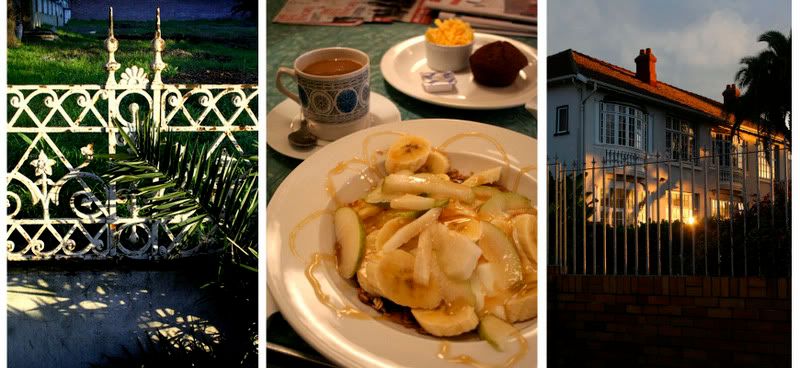 On my first morning in Cape Town, I sat down at Vida e Caffe and opened the newspaper. I don't normally read my horoscope, but this one stood out. Cape Times, June 2, 2007, "Leo (July 23-August 22): An auspicious term for resuming contact with special friends and foreign connections, with a view to setting up a reunion. If you already have a journey arranged, this should be an ideal time for successfully settling the details." The coincidence of reading this on my first morning back in South Africa, hours before a scheduled lunch with several old friends, was startling to say the least.
On my first morning in Cape Town, I sat down at Vida e Caffe and opened the newspaper. I don't normally read my horoscope, but this one stood out. Cape Times, June 2, 2007, "Leo (July 23-August 22): An auspicious term for resuming contact with special friends and foreign connections, with a view to setting up a reunion. If you already have a journey arranged, this should be an ideal time for successfully settling the details." The coincidence of reading this on my first morning back in South Africa, hours before a scheduled lunch with several old friends, was startling to say the least.While this horoscope bodes well for my brief return to South Africa, my first day in Cape Town actually had a rather inauspicious start. I spent the morning painfully hungover, consequence of the beer, margaritas, and tequila shots I had taken the night before to celebrate my return. After slowly drinking my long-awaited Vida latte (and forcing myself to finish a bottle of water, which for some reason my body was rejecting despite its dehydration) I walked up Bree Street to Frieda's, where I eventually settled on a bowl of muesli and a bran muffin as being the most curative option on the menu.
Maybe in sympathy for me, the city itself seemed to be suffering a bit of a hangover as well. It drizzled cold rain all day, and the cloud cover in the City Bowl was so thick that Table Mountain remained entirely concealed.
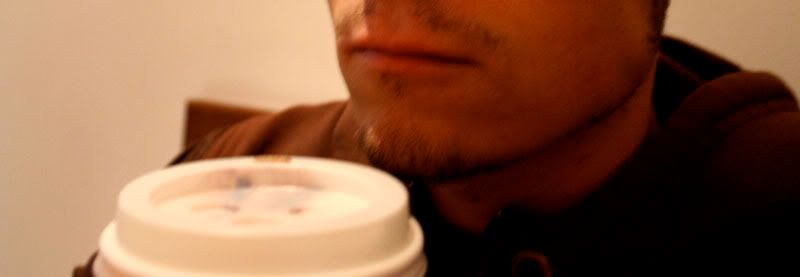
Themes:
Africa,
Cape Town,
Cape Town food and coffee,
South Africa
Sunday, June 03, 2007
New Mexico.
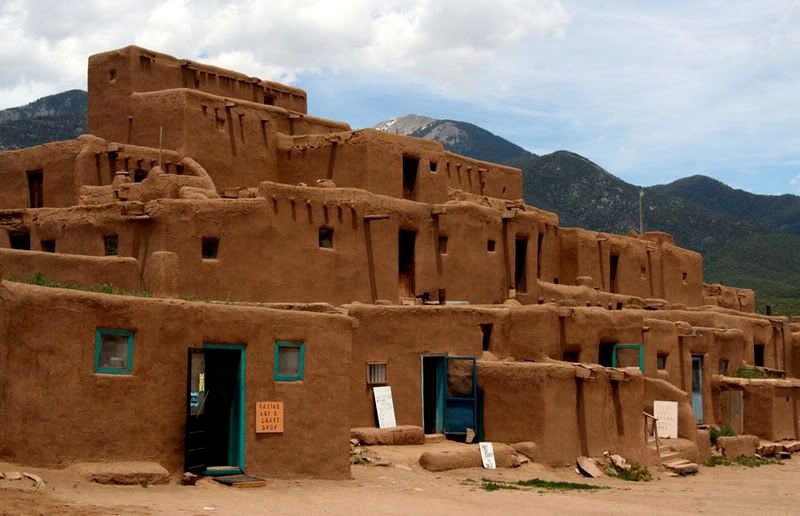 At the end of our long roadtrip was home for me, and a final American destination for Bordeaux. New Mexico.
At the end of our long roadtrip was home for me, and a final American destination for Bordeaux. New Mexico. Realizing this was a final chance for domesticity, Bordeaux and I spent much of our time hanging out at home; Bordeaux made dinner for my family, while I cleaned and organized my bedroom. We explored the city in small pieces, having dinner with my mom and sister downtown, and getting coffee among the various Satellite Coffees and Flying Stars. We tried nearly every coffee on menu at Satellite; I settled on the Turkish latte as my favorite, though with it's honey and cardamom flavor, it more closely resembles Bedouin Coffe. In the more than a week we spent there, our only real outing was to the Rio Grande Nature Center, where we were unable to find either beavers or toads at waters edge.
Realizing this was a final chance for domesticity, Bordeaux and I spent much of our time hanging out at home; Bordeaux made dinner for my family, while I cleaned and organized my bedroom. We explored the city in small pieces, having dinner with my mom and sister downtown, and getting coffee among the various Satellite Coffees and Flying Stars. We tried nearly every coffee on menu at Satellite; I settled on the Turkish latte as my favorite, though with it's honey and cardamom flavor, it more closely resembles Bedouin Coffe. In the more than a week we spent there, our only real outing was to the Rio Grande Nature Center, where we were unable to find either beavers or toads at waters edge. In our last weekend in the United States, we took a trip through Northern New Mexico with my family. We stopped for lunch in Santa Fe, where we waited in line for the amazing New Mexican food at Pascual's. After exploring the lobby at La Fonda, we looked through quirky shops around the Plaza, browsing among stationary and chocolates.
In our last weekend in the United States, we took a trip through Northern New Mexico with my family. We stopped for lunch in Santa Fe, where we waited in line for the amazing New Mexican food at Pascual's. After exploring the lobby at La Fonda, we looked through quirky shops around the Plaza, browsing among stationary and chocolates.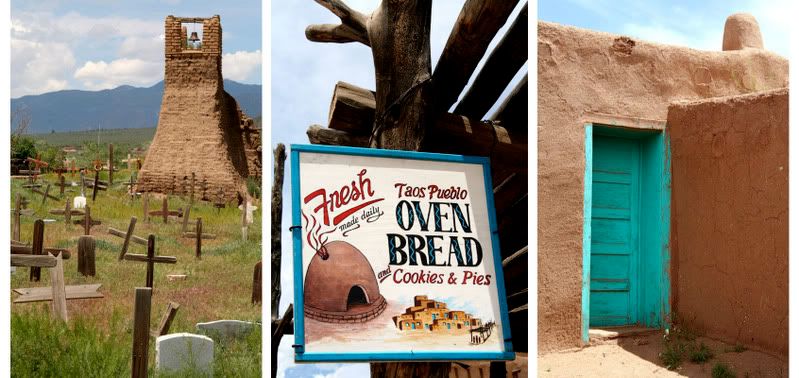 The main goal of our trip was Taos, where we stayed in a small house near the Plaza. We spent a day at Taos Pueblo, which is an odd attraction, seeing people in their homes.
The main goal of our trip was Taos, where we stayed in a small house near the Plaza. We spent a day at Taos Pueblo, which is an odd attraction, seeing people in their homes.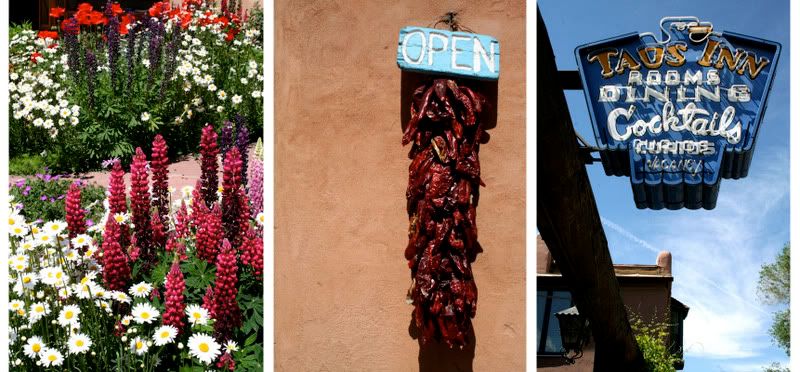 I enjoyed my time in Taos and Santa Fe, and even began to question whether I would be able to live there. I realized that I wasn't drawn to a New Mexico that was familiar, but one that had been invented, built on romantic ideas of Catholic mysticism and Southwestern flavor. I wondered if they only way I could move back to New Mexico would be to reinvent it, to cast it as something exotic. And if so, if that was my connection to New Mexico, what does that say about myself?
I enjoyed my time in Taos and Santa Fe, and even began to question whether I would be able to live there. I realized that I wasn't drawn to a New Mexico that was familiar, but one that had been invented, built on romantic ideas of Catholic mysticism and Southwestern flavor. I wondered if they only way I could move back to New Mexico would be to reinvent it, to cast it as something exotic. And if so, if that was my connection to New Mexico, what does that say about myself?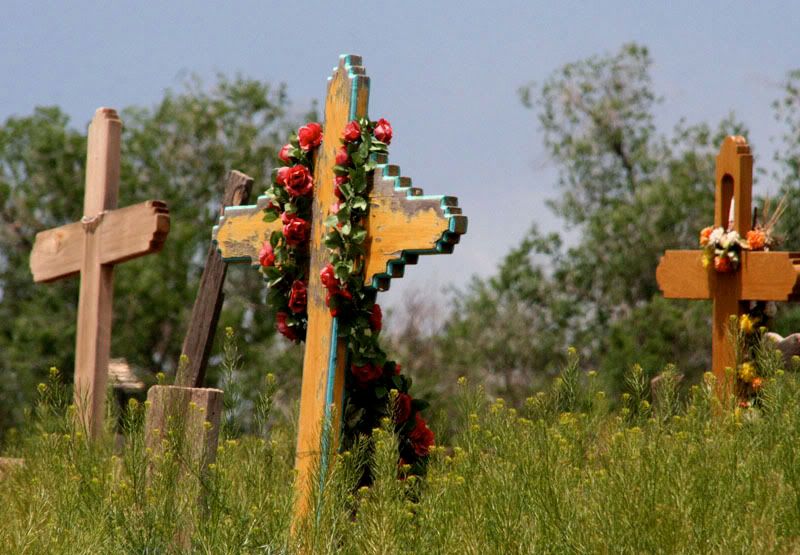
Themes:
Albuquerque,
New Mexico,
North America,
roadtrip,
USA
Subscribe to:
Posts (Atom)
